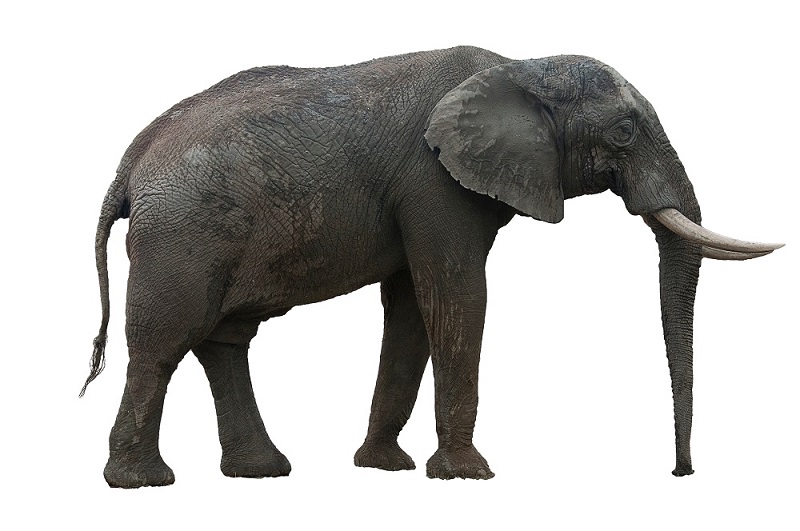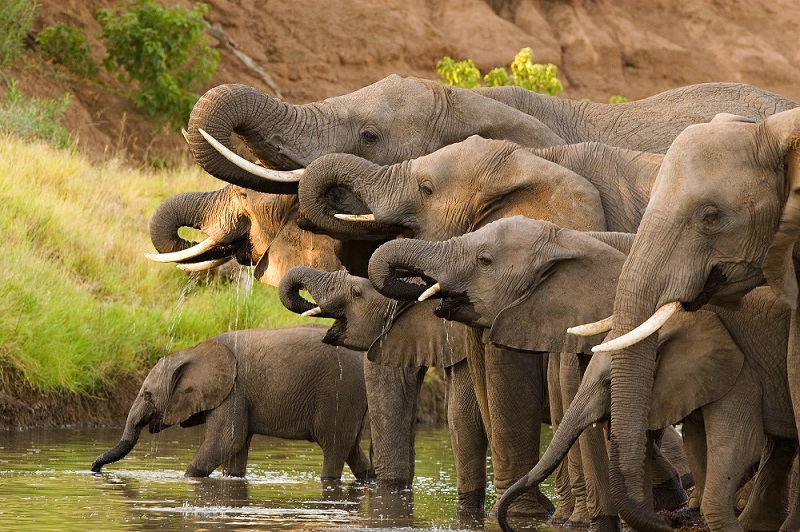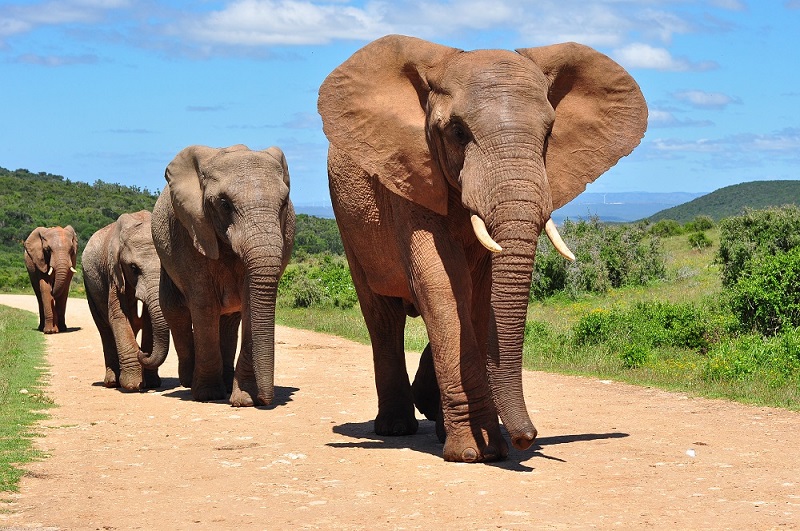
| Kingdom | Animalia |
| Phylum | Chordata |
| Class | Mammalia |
| Order | Proboscidea |
| Family | Elephantidae |
| Genus | Loxodonta |
| Species | L. africana & L. cyclotis |
| Niche | Large Herbivore |
| Size | 7-13 feet tall at the shoulder (2.2-4m) |
| Weight | 4,700 – 22,900 lbs (2,100 – 10,400kg) |
| Lifespan | > 65 Years |
| Social Structure | Family Units led by the oldest female (Matriarchy) |
| Conservation Status | Vulnerable |
| Preferred Habitat | African Savannas and Forests |
| Average Litter Size | 1 |
| Main Food Source | Grasses, Leaves, and other plants |
| Predators | Mostly Humans |
The Basics
African elephants have a very interesting social structure. Typically, the oldest female leads her family unit throughout the ecosystem, guiding them to water and food sources that she remembers. That old saying, “An elephant never forgets”, is based on the fact that this matriarchal leader can remember water and food sources that she discovered decades ago. This makes elephants very resistant to changes in food and water sources.
Elephants are typically peaceful and graceful creatures, despite their massive size. However, when food and water are scarce, elephants have been known to raid the agricultural fields of nearby human settlements. Unfortunately, this often leads to the death of the elephants as the farmers try to fight them off. But, there is hope that these interactions can be minimized.

Scientists recently discovered that African elephants show a huge aversion to bees. Apparently, angered bees will crawl inside the elephant’s trunk, and sting them where it really hurts! Thus, elephants have learned to avoid the sound of bees. Using this fact, farmers in Africa have recently started employing fences that carry beehives as a way to drive off invading elephants and encourage them to use natural sources of food and water. Plus, the bees help pollinate their crops!
The African Elephant is actually a grouping of two different species, the African bush elephant (L. africana) and the African forest elephant (L. cyclotis). While both species are massive, the African bush elephant is slightly larger and is the world’s largest living terrestrial animal. These species are often confused with the Asian Elephant.
African vs Asian Elephant
The Asian elephant (Elephas maximus) is in a completely different genus compared to the African elephant. Visually, you can distinguish between African Elephants and Asian Elephants based on the shape and size of the ears. Asian elephants have much smaller ears, which tuck much closer to their body. Asian elephants are also slightly smaller than African Elephants

In studying the African elephant, we can see some truly fascinating biological concepts!
Interesting Insights from the African Elephant!
The African elephant is an amazing and graceful species. Unfortunately, it is disappearing fast. The loss will be a huge hit to the African continent and humanity in general. Fortunately, African elephants can teach us much about biology. Hopefully, people can learn from elephants and will be encouraged to preserve them for future generations of scientists. Here’s what we can learn from African elephants:
Animal Intelligence
Elephants are among the world’s smartest creatures. Looking at an elephant’s brain, it is clear that elephants have the largest brain (by weight) and have similar brain-to-body ratios as primates and cetaceans (whales and dolphins). This suggests that African elephants have an enormous capacity to learn, reason, and feel complex emotions.
This fact is enhanced by the behaviors African elephants show in the wild. Herd matriarchs (female leaders) are able to lead the pack to food and water sources that the female has not seen since she was young. This decades-long memory serves to ensure that the herd will always be able to find food and water.

Elephants also show complex emotions and reasoning in nature. We can see these traits in elephant behaviors such as playing, tool use, and even recognition of the dead. It has been observed that elephants from many different herds will explore the dead body of another elephant, maybe to “pay their respects” or get a sense of what killed the elephant. This is not surprising, considering the very strong social bonds elephants form with one another and their massive intelligence.
Size vs Lifespan
A well-studied trend in biology is the “rate of living” theory, which postulates that the faster an animal’s metabolism, the faster it will die. This theory is based on extensive measurements of different animals and their lifespans. Using the African elephant and a mouse, for example, we can see that an elephant’s heart beats much slower, meaning it has a slower overall metabolism. The mouse’s heart beats much faster, and subsequently, mice live for a much shorter time.
However, this theory is highly generalized and has many exceptions. Bats and birds, for instance, live much longer than their heart rates would suggest. This is likely due to adaptations that increase the heart-rate for flying but do not affect other parts of the metabolism. Other species with specialized adaptations can also break this rule, but for the most part, size is directly related to lifespan.

Human Interactions
Unfortunately, there is a large body of evidence that suggests humans are destroying elephant populations and have been for some time. Science recognizes 4 extinct species of African Elephant, which likely went extinct due to competition and predation by the human species. While much of this extinction happened as humans expanded over the globe, the rapid decline of extant elephant species is still occurring.
Today, African elephants are poached often for their valuable ivory. Their tusks, which male elephants use to fight for mates, are made of solid ivory. Ivory is valuable in many cultures as raw material for art, and in certain cultures, ivory is considered a “medicine” (there is no scientific evidence to back these claims). Regardless, the loss of elephants in the wild today is largely due to sport hunting, poaching for ivory, and other human activities that reduce the ecosystem these magnificent animals live in.
The African elephant population sits around 350,000. However, nearly 27,000 elephants are killed every year simply for their ivory. That’s about 8% of the population. At that rate, African elephants could go completely extinct within 20 years.
